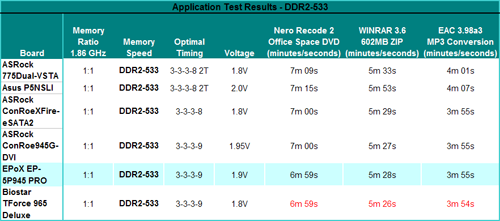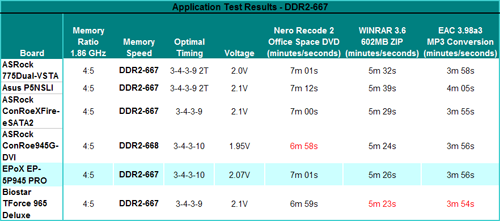EPoX EP-5P945 PRO: Budget 945P Performance
by Gary Key on September 11, 2006 4:45 AM EST- Posted in
- Motherboards
Application Performance
We also test motherboards with a few real world applications that typically stress the CPU, memory, and storage systems to see if the results from our synthetic memory tests carry over to the desktop. Our tasks include three activities that are common on the desktop.
Our first test was to measure the time it takes to shrink the entire Office Space DVD that was extracted with AnyDVD into a single 4.5GB DVD image utilizing Nero Recode 2. Our second test utilizes WinRAR 3.6 and measures the time it takes to compress our test folder that contains 444 files, 10 folders, and has 602MB of data.
Our third test consists of utilizing Exact Audio Copy as the front end for our version 3.98a3 of LAME. We set up EAC for variable bit rate encoding, burst mode for extraction, use external program for compression, and to start the external compressor upon extraction (EAC will read the next track while LAME is working on the previous track, thus removing a potential bottleneck with the optical drive). Our test CD is INXS Greatest Hits containing 16 tracks totaling 606MB of songs. The results of our tests are presented in minutes/seconds with lower numbers being better.
Our application test results mirror those of the synthetic results where the EPoX board scores better than the ASRock ConRoeXFire-eSATA2 based on the same 945P chipset but trails slightly behind the ASRock ConRoe945G-DVI board. The EPoX board is scoring consistently near the top in these tests. The differences between DDR2-533 and DDR2-667 memory is minor so we suggest utilizing low latency DDR2-533 with this board and utilizing the money saved on your GPU choice. Overall, the EPoX board performs well and can be considered a solid choice if your budget is limited.
We also test motherboards with a few real world applications that typically stress the CPU, memory, and storage systems to see if the results from our synthetic memory tests carry over to the desktop. Our tasks include three activities that are common on the desktop.
Our first test was to measure the time it takes to shrink the entire Office Space DVD that was extracted with AnyDVD into a single 4.5GB DVD image utilizing Nero Recode 2. Our second test utilizes WinRAR 3.6 and measures the time it takes to compress our test folder that contains 444 files, 10 folders, and has 602MB of data.
Our third test consists of utilizing Exact Audio Copy as the front end for our version 3.98a3 of LAME. We set up EAC for variable bit rate encoding, burst mode for extraction, use external program for compression, and to start the external compressor upon extraction (EAC will read the next track while LAME is working on the previous track, thus removing a potential bottleneck with the optical drive). Our test CD is INXS Greatest Hits containing 16 tracks totaling 606MB of songs. The results of our tests are presented in minutes/seconds with lower numbers being better.
 |
 |
| Click to enlarge |
Our application test results mirror those of the synthetic results where the EPoX board scores better than the ASRock ConRoeXFire-eSATA2 based on the same 945P chipset but trails slightly behind the ASRock ConRoe945G-DVI board. The EPoX board is scoring consistently near the top in these tests. The differences between DDR2-533 and DDR2-667 memory is minor so we suggest utilizing low latency DDR2-533 with this board and utilizing the money saved on your GPU choice. Overall, the EPoX board performs well and can be considered a solid choice if your budget is limited.










23 Comments
View All Comments
Zoomer - Monday, September 18, 2006 - link
While anandtech regularly bashes ATi/nVidia for paper launches, wouldn't this be a paper launch too? I can't find it for sale on the egg nor any other site.Gary Key - Wednesday, September 27, 2006 - link
I have contacted EPOX about supply, we purchased a retail board from NewEgg for comparison but according to our sources they do not have a firm delivery date so the board was pulled until an ETA is available.
Stele - Wednesday, September 13, 2006 - link
By the way, another noteworthy point of this review is the superb photography used. The level of detail and focus are excellent, and furthermore there is sufficient, white ambient lighting used so that the board isn't covered in off-colour shadows as if it were photographed under a sofa in the evening or something....While some people would dismiss the quality of motherboard photography as a non-issue, for some of us it's important to be able to see up close and gauge at least the layout of various components, connectors etc (better still if we could even see the details of certain components, as was very much the case in this review) without having to actually find a real sample of the board.
Stele - Tuesday, September 12, 2006 - link
Good review, as can be expected from Anandtech :)However, I would just like to point out a little misnomer that's becoming distressingly popular on the web... those little bare-metal capacitors are not called "solid state capacitors". They are, in fact, just aluminium electrolytic capacitors. The difference is that generally, the electrolyte used is of a solid type, rather than the liquid electrolyte the 'traditional' aluminium electrolytic capacitors contain.
Hence, if you want to differentiate them from the 'traditional' electrolytic capacitors, you could perhaps call them 'solid electrolytic capacitors' but certainly not 'solid state'... that is an old term used to describe circuits that do not use vacuum tubes, during the advent of transistors.
yyrkoon - Wednesday, September 13, 2006 - link
Suface mount, according to an EE buddy of mine.Stele - Wednesday, September 13, 2006 - link
I agree with him perfectly. As much as he's right if he were to call the components in question 'capacitors'. :)
Surface mount just means it's soldered onto the surface of the motherboard's PCB rather than using the traditional thin 'legs' that poke through holes in the PCB (such a component and mounting technology are called 'through-hole'). As such, while surface mount is an accurate description of the capacitors, it describes another aspect of the components in question altogether :)
However, because it is an accurate description nevertheless, calling these capacitors 'surface mount' is therefore actually more accurate than calling them 'solid state' ;) Yet the point reviewers are trying to make is not so much that the capacitors are surface-mount, but that they are not the traditional liquid electrolytic type that are more prone to leakage and failure under prolonged exposure to harsh operating evironments (thermally and electrically). Hence, the focus is more on the electrolyte type - solid vs. liquid - rather than surface-mount vs. through-hole.
blckgrffn - Monday, September 11, 2006 - link
I appreciate this timely review. I was trying to decide whether the GF was a getting a x2 or a Core Duo, and this board is going to solve my dillema.If only they had stuck the ICH7R or even just a 2 or 4 port SATA raid controller on there, as the lack of raid is really bogus now. A lot of my customers/friends want RAID1 for redundancy. I know this can be done in software, but hardware raid is much more transparent.
This board would be a no brainer if it included RAID.
Thanks again,
Nat
yyrkoon - Monday, September 11, 2006 - link
Well, of course I cannot speak for you, or anyone else, but in my opinion, RAID 1 is a bad idea for anyone who is likely to muck up a system. I find that non RAID (possibly USB drive backups, or whatever else you preffer), are often better, and have greater flexability. Another thing to note, is that if Windows isnt nessisary, Linux / BSD RAID 0,RAID 1 is nearly, if not just as fast as Hardware RAID. Also, incremental ghosting of a system drive is another option which is much more flexable.Basicly, the only real reason for RAID 1, is in the event of hardware failure, and if you purchase with this in mind, there is no reason why a HDD cant live for 5-8 years easily.
blckgrffn - Monday, September 11, 2006 - link
Try telling users with 100's of gigs of photos or videos that there HD should have lasted 5 years, not 5 months. I have already been there and it isn't comfortable. There is a reason dell is offering RAID 1 on nearly every desktop model they have. It's the easiest, most transparent way to send your MTBF into the stratosphere.Second, my $80 EVGA SLI mobo has all those features, as do many AMD catered motherboards. In the past, Intel boards have also come down to reasonable levels.
I stoutly refuse to spend more on a mobo than a processor, sorry. And I am not paying $150 for a board that has been gutted of features expected of a high to medium end motherboard.
Nat
yyrkoon - Monday, September 11, 2006 - link
And yes, we run a PC buisness here also, and have yet to see a HDD reguardless of how bad off, that we couldnt pull the data off. Most of the time, you just put the drive in another machine, pull the data off, and thats that. Once in a blue moon you have to send the drive off to have a company equiped with the hardware to get at the data, but that is extremely rare. RAID 1 wont work for an accidental deletion, and the like, thats where its the buisness owners responcability to educate average PC users for each situation, and not just try to make a quick 10%-15%(on a HDD) by selling another drive.